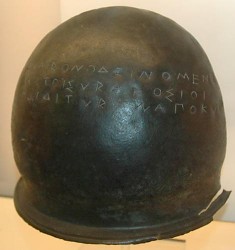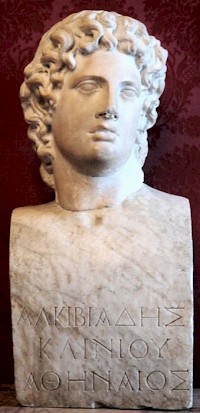Sicily (3)
Q1460Sicily: large and rich island opposite the Italian mainland. In Antiquity, it was settled by Phoenicians and Greeks, and contested by the Carthaginians, Romans, Ostrogoths, and Byzantines.
Fifth Century

The last decade of the sixth century was one upheaval in the Greek-Italian world. In Athens, the tyrant Hippias was expelled; in Sparta, king Cleomenes behaved like a tyrant; in Rome, the tyrannical king Tarquinius Superbus was expelled, which created great havoc in central Italy; Sybaris and Croton were at war in southern Italy; and on Sicily, the mercenaries of the tyrant Hippocrates of Gela conquered the eastern part if the island. Meanwhile, colonists from Sparta (led by Cleomenes' brother Dorieus) and Samos settled on Sicily as well. This turmoil marked, in more than one sense, the beginning of a new century.
Hippocrates died in 491/490 and was succeeded as tyrant of Gela by his adjutant Gelon, who conquered Syracuse and was now lord of almost every town in eastern Sicily: Gela and Syracuse of course, but also Camarina, Leontini, Catane, Naxos, and several towns of the Siculians. He resettled many people and made Syracuse, with its excellent harbor, into his capital and one of the most important cities in the Greek world, an equal of Sparta, Miletus, Athens, Corinth, and Thebes. Yet, Gelon was an odd tyrant, because he collaborated with the rich people in his territorial state - tyrants usually found their supporters among the urban poor.

By the end of the 480s, the Carthaginian decided to intervene. They feared Gelon and his ally Theron of Acragas, and when the latter captured Himera, they decided to restore it to its tyrant Terillus. The Carthaginian commander Hamilcar built up a large army and navy in the far west of Sicily and started to besiege Himera. Theron, however, held out and Gelon was able to defeat the Carthaginians decisively. According to later legend, the victory at Himera, where the western Greeks had been liberated from the Carthaginian threat, took place on the very day of the Greek defeat at Thermopylae.

In 478, Gelon died. He was succeeded by his brother Hiero, who continued the policy of resettling people in large cities -Aetna was newly founded and received 10,000 colonists from Syracuse and the Peloponnese- and aggressive interference in foreign affairs. In c.474, he defeated the Etruscans near Cumae and founded a new city on the island Pithecusae, close to Cumae, just outside the Bay of Naples. At the same time, his court became an influential center of Greek culture, visited by poets like Pindar and Aeschylus.
One of the aims of the resettlement of people was to divide the opposition against the tyranny of Gelon and Hiero, but in the end, the people united and demanded their share in the political process. In 467, Hiero died, and his brother Thrasybulus was expelled. From now on, Syracuse was to be a democracy, the tyrant's mercenary armies were disbanded, and many people who had been resettled now returned to their homes. The revolution, however, also meant that the city lost its grip on the towns it had conquered. At the same time, a native leader named Ducetius started to copy Greek methods. In the years 461-440, he was able to organize a territorial state.

Meanwhile, Athens started to show an interest in the western island, which had, until then, been part of the Corinthian and Spartan "backyard". This was not the natural course of events. In 444, Athens had been invited to found a town named Thurii in southern Italy (the researcher Herodotus was one of the settlers), but Athens had made it into a "panhellenic" or all-Greek town to prevent a provocation of Corinth. However, in the late 430s, the Athenians allied themselves to Corcyra (Corfu), which gave them control of the Ionian Sea. This was one of the causes of the Archidamian War (431-421), in which many Italian and Sicilian towns supported Sparta and Corinth against Athens. Between 427 and 424, an Athenian navy showed itself in the west, and the Athenians allied themselves to the native population of Sicily.
However, the Sicilian cities were now aware of Athenian power, and during a conference at Gela, organized by the Syracusan democratic leader Hermocrates, decided to make peace with one another and exclude the foreigners from the island. Almost immediately, an Athenian diplomat named Phaeax concluded alliances with Acragas, Camarina and the natives, because the conference at Gela had not taken away the mutual suspicion that was common among Greek cities.

In 421, Sparta and Athens concluded a peace treaty, and the Athenians, having their hands free, sent out an armada to conquer Sicily. Its commanders were Lamachus, Nicias, and Alcibiades. In 415, the ships arrived, but after initial successes, the recall of Alcibiades, the death of Lamachus, and the arrival of a Spartan military adviser to help their Sicilians, it turned out that the Athenians were unable to capture Syracuse (413; more...). The expeditionary force was destroyed, and Syracuse sided with Sparta in the Decelean or Ionian War (413-404), which was to culminate in the fall of Athens and the dismantling of its empire.
Hermocrates commanded the Syracusan contingent, but in his absence, the radical democrats seized power, and he learned that his return was no longer appreciated. At the same time, the town of Selinus saw its chance in its conflict with Segesta, a former ally of Athens. The Segestans were pushed back and invited the Carthaginians to come to their assistance. Immediately, the Syracusan democrats announced their support for Selinus.
In 408, a large Carthaginian army commanded by a man named Hannibal landed at Lilybaeum and carried Selinus by assault. The invaders proceeded to Himera and captured the city where they had been defeated by Gelon of Syracuse 72 years before. The repercussions in Syracuse were grave. There were fights between the moderate and radical democrats, and Hermocrates, who tried to obtain the right to return, was killed.
The Carthaginians were encouraged, and their general Himilco attacked Acragas, the main Sicilian city after Syracuse (406). After a protracted siege and the defeat of a Greek rescue army, the town was evacuated, and the invaders proceeded to Gela. To the Greeks, the situation was desperate, and in the first weeks of 405, the Syracusans started to look for new leaders. They appointed as strategos autokrator ("sole general with absolute powers") the man who was to lead them into the fourth century: Dionysius.